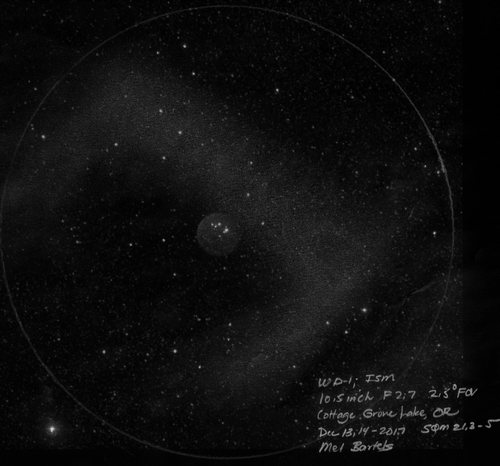WD-1 is a newly identified hydrogen-alpha emission nebula about 20’ round associated with the star HD 237299, an early-type emission-line B3 star, first identified by the MDW Hydrogen-Alpha Sky Survey but visible in earlier H-Alpha surveys.
The first night I could not see WD-1 using a 13.2 inch [34cm] F3.0 telescope under good transparency (SQM=21.5). I tried DGM’s NPB and Orion’s SkyGlow, the latter providing a slightly more contrasty view. I did find a band of nebulosity, likely InterStellarMedium (ISM) because of its proximity to the galactic plane.
I don’t mind negative observations – I’ve certainly made enough of them – but I have more objects to sketch and time under transparent skies is precious. Plus a Geminid blazed across the center of the field, staggering me backwards and leaving me with an after-impression that lasted for a couple of minutes, ruining my dark adaptation.
Needing to confirm a detail in my sketch, the next night I grabbed my 10.5 inch [27cm] F2.7. The skies, filled with cirrus earlier, were unexpectedly clear. SQM was not quite as good as the night before (21.3 vs 21.5) but the air was drier.
I employ a different finding technique than most in that I identify an unusual star asterism nearby, point the scope in the proper direction with a red dot finder and then scan for the asterism: I don’t star hop. I centered the star asterism almost immediately and to my utter surprise, there it was, WD-1, sharp edged, faint but clearly distinguishable from the jet black sky background to the southeast. There was more ISM than the night before, brighter with more delineation. Particularly interesting was the impression of hue. The ISM was grey-white, the background black, but WD-1? It was a charcoal hue, different from the ISM.

I am struck by the sharp difference between the eyepiece view and images that more and more are composed of narrow-bands. Digital imagers invariably heavily processed the sky background so as to hide sky noise. Digital images rarely mirrored the visual experience; now they deviate to the point where they no longer serve as guides to the visual experience. They are their own experience; not superior to visual, just different truths.
Perhaps I should have used a camera and H-alpha filter but I would have missed the ISM crossing the field. New experiences are exploding in the amateur astronomy world: near real time imaging through seamless stacking, video cameras, narrow-band imaging. Novel experiences sit just over the horizon like virtual imaging via data mining using tremendous data repositories that LSST and others will soon build.
Experiences in my lifetime have disappeared: building a cold camera, manually guiding an exposure, developing in the dark room, enlarging with burning and dodging, perhaps even a little crude unsharp masking; hypering film; grinding a 6 inch [15cm] F8 mirror, building the tube assembly and equatorial pipe mount, tracking down M13, the Hercules Cluster. Millions of variable star observations have been submitted to the AAVSO, first visual, now digital. Some experiences such as stepping outside into truly dark skies are profoundly missing from our shared experience.
Would you give up all our modern experiences to return to a dark night? I would, without a doubt, I think. New experiences come at us faster, our attention shifts quicker, there is less time to truly master. We break apart into silos rarely able to appreciate the experiences of others.